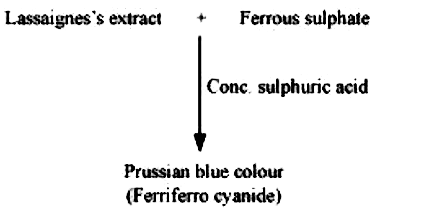Discuss the chemistry of Lassaigne’s test.
Lassaigne’s test
This test is employed to detect the presence of nitrogen, sulphur, halogens, and phosphorous in an organic compound. These elements are present in the covalent form in an organic compound. These are converted into the ionic form by fusing the compound with sodium metal.
Na+C+NΔ−−→NaCN
2Na+SΔ−−→Na2S
Na+XΔ−−→NaX
(X=Cl,Br,I)
The cyanide, sulphide, and halide of sodium formed are extracted from the fused mass by boiling it in distilled water. The extract so obtained is called Lassaigne’s extract. This Lassaigne’s extract is then tested for the presence of nitrogen, sulphur, halogens, and phosphorous.
(a) Test for nitrogen

Chemistry of the test
In the Lassaigne’s test for nitrogen in an organic compound, the sodium fusion extract is boiled with iron (II) sulphate and then acidified with sulphuric acid. In the process, sodium cyanide first reacts with iron (II) sulphate and forms sodium hexacyanoferrate (II). Then, on heating with sulphuric acid, some iron (II) gets oxidised to form iron (III) hexacyanoferrate (II), which is Prussian blue in colour. The chemical equations involved in the reaction can be represented as
6CN−+Fe2+→[Fe(CN)6]4−
3[Fe(CN)6]4−+4Fe3+xH2O−−→Fe4[Fe(CN)6]3.xH2OPrussian blue
(b) Test for sulphur
(i) Lassaigne's extract + Lead acetateacetic acid−−−−−→Black precipitate
Chemistry of the test
In the Lassaigne’s test for sulphur in an organic compound, the sodium fusion extract is acidified with acetic acid and then lead acetate is added to it. The precipitation of lead sulphide, which is black in colour, indicates the presence of sulphur in the compound.
S2−+Pb2+→PbS(Black)
(ii) Lassaigne's extract+ Sodium nitroprusside→Violet colour
Chemistry of the test
The sodium fusion extract is treated with sodium nitroprusside. Appearance of violet colour also indicates the presence of sulphur in the compound.
S2−+[Fe(CN)5NO]2−→[Fe(CN)5NOS]−4Violet
If in an organic compound, both nitrogen and sulphur are present, then instead of NaCN, formation of NaSCN takes place.
Na + C + N + S → NaSCN
This NaSCN (sodium thiocyanate) gives a blood red colour. Prussian colour is not formed due to the absence of free cyanide ions.
Fe3++SCN−→[Fe(SCN)]2+(Blood red)
(c) Test for halogens

Chemistry of the test
In the Lassaigne’s test for halogens in an organic compound, the sodium fusion extract is acidified with nitric acid and then treated with silver nitrate
X−+Ag+→AgX
(X=Cl,Br,I)
If nitrogen and sulphur both are present in the organic compound, then the Lassaigne’s extract is boiled to expel nitrogen and sulphur, which would otherwise interfere in the test for halogens.
Topper's Solved these Questions
- BOOK - NCERT ENGLISHCHAPTER - ORGANIC CHEMISTRY- SOME BASIC PRINCIPLES AND TECHNIQUESEXERCISE - EXERCISE40videos
ORGANIC CHEMISTRY- SOME BASIC PRINCIPLES AND TECHNIQUES
- BOOK - NCERT ENGLISHCHAPTER - HYDROGENEXERCISE - EXERCISE36videos
HYDROGEN
- BOOK - NCERT ENGLISHCHAPTER - REDOX REACTIONSEXERCISE - EXERCISE30videos
REDOX REACTIONS
Similar Questions
Knowledge Check
- Question 1 - Select One
The prussian blue colour obtained durign the test of nitrogen by Lassaigne's test is due to the formatio of:
AFe[Fe(CN)6]3BNa3[Fe(CN)6]CFe(CN)3DNa4[Fe(CN)6NOS]
What is Lassaigne's solution and how is it prepared ? Discuss the chemistry of the tests used for the detection of following elements using this solution.
BrView SolutionWhat is Lassaigne's solution and how is it prepared ? Discuss the chemistry of the tests used for the detection of following elements using this solution.
ClView SolutionWhat is Lassaigne's solution and how is it prepared ? Discuss the chemistry of the tests used for the detection of following elements using this solution.
(A) SulphurView SolutionWhat is the chemistry of chromyl chloride test?
View SolutionGive the chemistry of sliver mirror test and Fehling solution test for glucose.
View SolutionF cannot be tested by "Lassaigne’s test" because
View SolutionNitrogen detection in an organic compound is carried out by Lassaigne’s test. The blue colour formed corresponds to which of the following formulae?
View Solution

